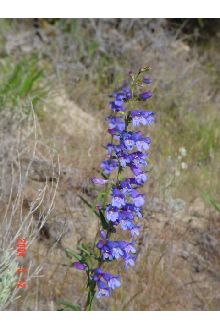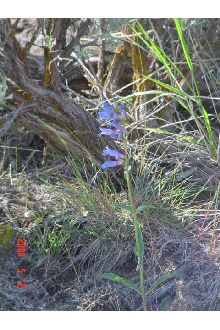Blue Penstemon
Scientific Name: Penstemon cyaneus Pennell

| General Information | |
|---|---|
| Usda Symbol | PECY3 |
| Group | Dicot |
| Life Cycle | Perennial |
| Growth Habits | Forb/herbSubshrub, |
| Native Locations | PECY3 |
Plant Guide
Alternate Names
Dark blue penstemon
Uses
Blue penstemon is suited for use in restoration and wildlife enhancement plantings. It is not noted for having value as forage for livestock, and forage use is limited by big game. The fibrous root system and wide canopy cover make it a good plant for low-water use landscaping (i.e. roadsides) and other ornamental plantings. Blue penstemon’s large showy flowers attract pollinators and other insects which provide a food source for birds and other animals. Blue penstemon is known to attract several species of native pollinators including bumble bees (Bombus spp.), mason bees (Osmia spp.) and Andrena spp (Cane, 2011).
Status
Please consult the PLANTS Web site and your State Department of Natural Resources for this plant’s current status (e.g., threatened or endangered species, state noxious status, and wetland indicator values).
Description
General: Figwort family (Scrophulariaceae). Blue penstemon is a native perennial sub-shrub with several stems arising from a branched woody caudex. At maturity the plant reaches 30 to 70 cm (12 to 28 in) tall. The basal leaves are clustered near the base and are approximately 15 cm (6 in) long and 2.5 cm (1 in) wide and petiolate. The stem leaves are smaller, approximately 11 cm (4 in) long and sessile to clasping. The inflorescence is a loose spike of flowers born in the upper leaf axils. The flowers are bright blue often suffused with pink, 2.5 to 3.5 cm (1 to 1.5 in) long and about 1 cm (0.5 in) wide at the mouth (Hitchcock and others, 1959). The seeds are approximately 2 mm (0.08 in) long. There are wide discrepancies between seed counts available for the species. Winslow (2011) obtained seed counts from 5 seed lots from wildland collections made in Yellowstone National Park. The average for these lots was 13,000,000 seeds/kg (5,900,000 seeds/lb), while Lambert (2005) lists 396,000 seeds/kg (180,000 seeds/lb). The USDA Forest Service, Rocky Mountain Research Station reported 1,760,000 seeds/kg (800,000 seeds/lb) from agriculturally produced seed. Distribution: Blue penstemon occurs naturally throughout most of Idaho and in northwestern Wyoming and southwestern Montana. For current distribution, please consult the Plant Profile page for this species on the PLANTS Web site. Habitat: This species grows in open dry areas on sagebrush slopes at moderate elevations and in higher plains (Davis, 1952).
Adaptation
Blue penstemon is adapted to well-drained, coarse soils in areas receiving 40 to 65 cm (16 to 25 in) of annual precipitation (University of Wyoming, 2011). Because blue penstemon is found in regions with long winter snowpack, the seed is highly dormant. Chilling periods of less than 24 weeks have little response in overcoming seed dormancy (Meyer and Kitchen 1994).
Establishment
The full stand seeding rate, based on 50 pure live seeds (PLS) per foot at 30 cm (12 in) spacing, is 6 kg/ac (3 lbs/ac). When planted in a mixture, the seeding rate should be adjusted according to the proportion of blue penstemon in the mix. Blue penstemon has high levels of seed dormancy. This species should be seeded in late fall as a dormant seeding to allow for natural over-winter stratification.
Management
Blue penstemon should be used as a minor component of seed mixtures. Management strategies should be based on the key species in the established plant community. Grazing should be deferred on seeded lands for at least two growing seasons to allow for full stand establishment (Ogle and others, 2011).
Pests and Potential Problems
Blue penstemon is very susceptible to root rot infections (Skinner, 2011). Root rot can be prevented by limiting irrigation.
Environmental Concerns
Concerns
Concerns
Blue penstemon is native to the Intermountain Western region of the United States. There are no known environmental concerns associated with this species.
Seeds and Plant Production
Plant Production , Use soil moisture sensors to measure the soil moisture of Blue Penstemon.
Plant Production
Field plantings should be conducted in late fall for natural stratification. In greenhouse plant production, treatment of seed with gibberellic acid (GA3) may reduce the stratification requirement (Kitchen and Meyer, 1991). The seed bed should be well firmed and weed free. Seed increase fields can be planted at 2 kg/ac (1 lb/ac), 25 to 30 PLS per linear foot with 56 to 91 cm (22 to36 in) row spacing for between row cultivation. Seed can also be sown into holes cut or burned into weed-barrier fabric. The seed is very small; adding a dilutent such as rice hulls or cracked grain can provide more accurate seed flow through planting equipment. Seed fields should be irrigated as necessary to maintain adequate soil moisture and to prevent crusting. However overwatering can cause root rot infections. No overhead irrigation should be applied during pollination. Fertilizer should not be added the first year, as this will benefit weeds more than the crop species. In subsequent years fertilizer is applied at 100 lbs actual N and 40 lbs actual P/acre in mid-September (Winslow, 2002). Weed control is done primarily via hand roguing. Grass weeds can be controlled with a grass selective herbicide. Additional weed control can be achieved by spraying glyphosate after the penstemon plants have gone dormant in late summer or prior to greenup in the spring. Always read and follow label directions when applying pesticides. Blue penstemon takes two full growing seasons to establish. Seed productions fields will produce for approximately 3 growing seasons. Seed is harvested in late July to early August before capsules have shattered. The seed can be hand harvested or cut into windrows and harvested with a combine (Skinner, 2011). Collected seed should be dried thoroughly prior to processing. Thresh capsules with a hammermill and then clean with a screen cleaner with light air. Seed will keep in storage under low temperatures and low humidity for 5 to 7 years (Winslow, 2002). Cultivars, Improved, and Selected Materials (and area of origin) Common wildland collected seed is available from commercial sources. There are currently no commercial releases of blue penstemon.
References
Cane, J. 2011. Personal communication. Logan (UT) USDA-Agricultural Research Service, Bee Systematics and Biology Laboratory. Davis, R.J. 1952. Flora of Idaho. Brigham Young University Press. Provo, Utah.836p. Hitchcock, C.L., Cronquist, A., Ownbey, M., and J.W. Thompson. 1959. Vascular Plants of the Pacific Northwest. Part 4: Ericaceae through Campanulaceae. University of Washington Press. Seattle, Washington. 510p. Kitchen, S.G. and S.E. Meyer. 1991. Seed germination of Intermountain penstemons as influenced by stratification and GA3 treatments. J. Environ. Hort. 9(1): 51-56. Lambert, S. 2005. Guidebook to the seeds of native and non-native grasses, forbs and shrubs of the Great Basin. Boise (ID): USDI-Bureau of Land Management. 136p. Meyer, S.E. and S.G. Kitchen. 1994. Habitat-correlated variation in seed germination response to chilling in Penstemon section glabri (scrophulariaceae). Am. Midl. Nat. 132: 349-365. Ogle, D., St. John, L.,. Stannard, M. and L. Holzworth. 2011. Technical Note 24: Conservation plant species for the Intermountain West. USDA-NRCS, Boise, ID-Salt Lake City, UT-Spokane, WA. ID-TN 24. 57p. Skinner, J. 2011. Personal communication. New Plymouth (ID): Skinner Seed Farm. Owner. University of Wyoming. 2011. Native Plants for the Intermountain West. URL: http://www.uwyo.edu/wera1013/plantlist_penstemoncyaneus.asp (accessed 19 December 2011). Laramie (WY): University of Wyoming. College of Agriculture and Natural Resources. Winslow, S.R. 2002. Propagation protocol for production of Penstemon cyaneus seeds; USDA NRCS - Bridger Plant Materials Center, Bridger, Montana. In: Native Plant Network. URL: http://www.nativeplantnetwork.org (accessed 15 December 2011). Moscow (ID): University of Idaho, College of Natural Resources, Forest Research Nursery. Winslow, S.R. 2011. Personal communication. Bridger (MT). USDA-NRCS. Bridger Plant Materials Center. Agronomist. Prepared By: Derek Tilley, USDA NRCS Plant Materials Center, Aberdeen, ID Loren St. John, USDA NRCS Plant Materials Center, Aberdeen, ID Dan Ogle, USDA NRCS Idaho State Office, Boise, ID Nancy Shaw. USDA-FS. Rocky Mountain Research Station. Boise, Idaho. Citation TIlley, D., St. John, L., Ogle, D., and N. Shaw. 2012. Plant Guide for blue penstemon (Penstemon cyaneus). USDA-Natural Resources Conservation Service, Aberdeen Plant Materials Center. Aberdeen, Idaho 83210. Published January, 2012 Edited: 22Dec2011 djt; 4Jan2012ls; 6Jan2012ns; 14Jan2012gm For more information about this and other plants, please contact your local NRCS field office or

